The Original Ultimate Runner Competition
The Original Ultimate Runner Competition consisted of running a 10k, 400 meters, 100 meters, a mile, and marathon all on the same day. The original Ultimate Runner Competition sought to answer these questions: Was a miler or middle-distance runner the best runner in the world? Was a sprinter the best in the world? Was a marathon runner or ultra-marathon runner the best runner in the world?
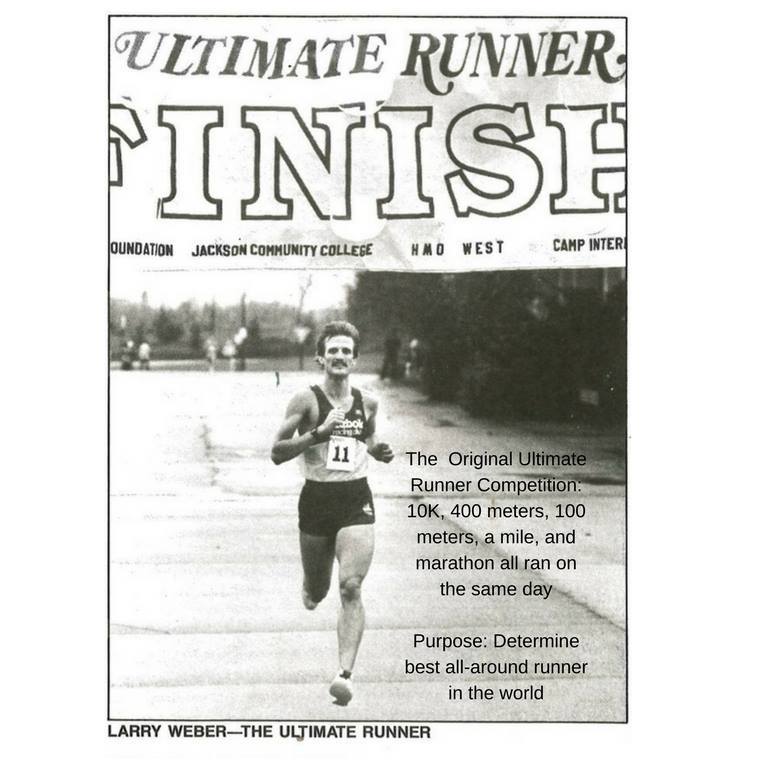
I was a nationally ranked miler by my late 20s. However, aging legs are not a friend to a national-class runner. It was nearly time to hang up my spikes and move to the following chapters of life. I was in the final steps of my competitive running career, looking for one last challenge before I put my spikes away.
When I saw the advertisement for the Ultimate Runner Competition in a national running magazine, I jumped at the chance to compete. The race seemed like climbing Mt. Everest to me at the time. It was the battle and adventure I was looking for at the time. You see, the original Ultimate Runner Competition consisted of running a 10k, 400 meters, 100 meters, mile, and marathon on the same day.
Some of the world's best runners at various distances gathered to compete in The Ultimate Runner Competition.
The original Ultimate Runner Competition sought to answer these questions: Was a miler or middle-distance runner the best runner in the world? Was a sprinter the best in the world? Was a marathon runner or an ultra-marathon runner the best runner in the world?
The original Ultimate Runner Competition winner was honored as the best all-around runner in the world, much like track and field honors, where the Olympic decathlon winner is considered the best all-around athlete in the world, and the Iron Man competition determines the best triathlete in the world.
The goal of the Original Ultimate Runner Competition was to test the limits of human endurance in one day. The founders of the race reached their goal. The original Ultimate Runner Competition (it no longer exists) was the most challenging endurance event of my life.
Runner's World Magazine writer Jim Harmon covered the race one year and had this to say about The Ultimate Runner: "This competition may be the last word in running endurance."
Imagine for a moment running at nearly top speed for over 33 miles in one day. Running 33 miles in five different races at a fast pace is a level of pain that I had never experienced before or since this race. Running in and out of oxygen debt all day long was pretty tough, especially in the final event of the day, the marathon.
Some of the world's top ultra-marathon runners competed in the original Ultimate Runner Competition, including Barney Klecker, the American record holder at 50 miles. Klecker held the American record at this distance for almost 40 years. On a side note, Klecker's son, Joe, made the 2021 Olympic team in the 10,000 meters. Charlie Trayer was the world's number three-ranked ultramarathon runner at the time.
Charlie was also named the Ultra-Running Magazine Ultra Runner of the Year in 1987. Stefan Feckner, the Ultra-Running Magazine Ultra Runner of 1988, also competed in the Original Ultimate Runner Competition.
The ultra-guys were attracted to this race because it was one of the most challenging running events ever created. These tough guys think running 100 miles in a day is normal!
Don Kardong, a former U.S. Olympian and fourth-place finisher in the Olympic Games marathon, competed in the Ultimate Runner one year and wrote about his race experiences. In his usual humorous style, Kardong and a writer from the American Running Association had some funny yet spot-on things to say about his participation in the Ultimate Runner Competition:
"When Kardong heard about the Ultimate Runner competition in Jackson, Michigan, of course, he went. This diabolical contest has you run a 10K race in the morning, 400 meters, 100 meters, and a mile around midday, and for the afternoon, a marathon. Kardong is funny. He recalls passing a dead raccoon in the last couple of miles of the marathon, "I thought the roadkill looked better than I felt. "He placed fifth overall…".
Olympian and famous running author Jeff Galloway competed in the Ultimate Runner event once and said, "I haven't had this much fun since Viet Nam."
John Craig was a thirteen-time member of Canada's national team, winning the national title six times and holding the Canadian record in his day. He made Canada's Olympic 1500-meter team in 1980, when Canada and other countries boycotted the games in Moscow. Craig said that the original Ultimate Runner was a great experience, but he would never do it again because it was too physically demanding for him. These are strong words coming from someone with such an impressive athletic background.
Kardong's humor sums up the event best. The race was
brutally hard, and nothing was left in the tank when you finished. Galloway's comment conveys the same message differently.
The race turned out to be a battle of will from the very first step. National record holders in ultra-marathon events, road racing champions, elite marathon runners, and Olympic athletes in the 1500 and 5000 meters competed for The Ultimate Runner's title at its peak in popularity. I was not on anyone's radar to win this event.
You could almost hear a pin drop at the beginning of the competition, the day I ran the race. Every elite runner in the field was extraordinarily focused and wanted to win the race.
By the end of the competition, I was crowned "The Ultimate Runner," setting a new record for the event. I finished ahead of several national and world-class runners I had never beaten. I was blessed to end up number one on the all-time Ultimate Runner point total list, ahead of 1500-meter and 5000-meter Olympians, marathon champions, and ultra-marathon national record holders.
Winning the Ultimate Runner Competition took every ounce of mental, physical, and spiritual strength that I could find deep down inside that day. That afternoon, the meet officials had to lift me onto the stage at the awards ceremony to receive my first-place award because my legs were like jelly.
Space constraints prevent me from sharing the full extent of the transformative experiences and lessons I encountered that day. Nevertheless, I can share that I prayed and concentrated as never before, learned to endure physical pain more effectively, and, most significantly, started to grasp the meaning of Philippians 4:13. This verse became a significant focus in my life following that event.
My perception of fatigue and endurance also changed after the original Ultimate Runner competition. I no longer bought into the accepted physiological limits of the day. We can all do more than we initially think in life's endurance and mental realms.
In summary, the original Ultimate Runner Competition was the mental and physical test of a lifetime. I am grateful and cherished the opportunity to test human endurance limits as a young man. The event taught me a great deal about running and life—we can always do more than we initially think we can.
Keep pushing forward toward your dreams. Never give in to pain along the way. All things are possible for those who believe.
Blessings,
Coach Weber
Philippians 4:13
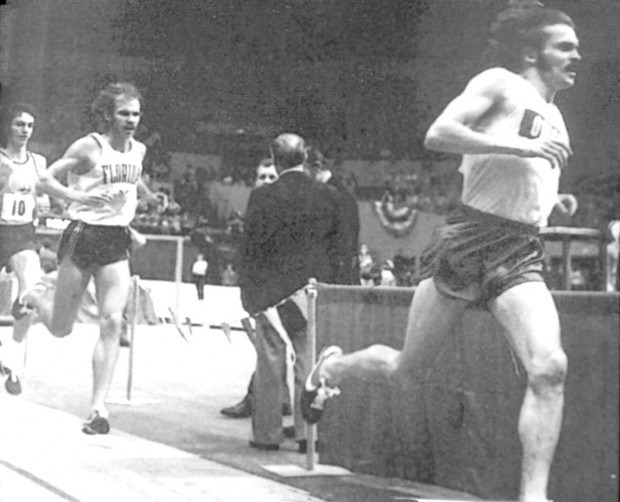
Marathon Olympians and writers Don Kardong and Jeff Galloway ran in the Original Ultimate Runner Competition one year. They are seen here running behind American running legend Steve Prefontaine. Photo credit is unknown.

Barney Klecker participated in the Original Ultimate Runner Competition and held the American record for 50 miles for nearly 40 years. His son, Joe Klecker, was on the 2021 Olympic Team in the 10,000 meters event, while his wife, Janis, was a member of the USA Women's Olympic Marathon team.
Barney is in the American Ultra Runners Hall of Fame here: Barney Klecker – 2010 Hall of Fame Member | Ultrarunning History
Photo Credit is unknown.
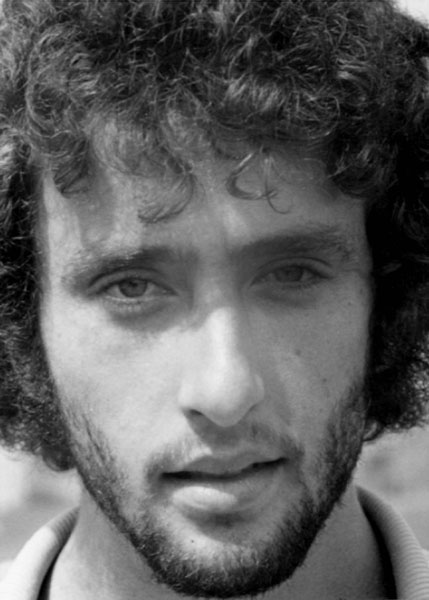
John Craig, a Canadian athlete, qualified for the 1500-meter Olympic team but could not participate in the 1980 Moscow Olympics due to the boycott. Craig had an exceptional track career, representing Canada thirteen times on the national team. He competed in the 1978 Commonwealth Games, 1979 Pan Am Games, 1980 Olympic Games (although he was a team member for the boycotted Games), and 1981 World Cup. Craig was a six-time national 1500-meter champion and a former Canadian record holder at his national meet for 29 years. He was also a national road racing champion.
Image Credit: CP Photo/COA)

Paul Craig, John Craig's twin, did not run in the Ultimate Runner but the two battled it out year after year in the 1500 meters. Their 1500-meter times were within about a half of second of each other. Paul is seen here running against Olympic 1500-meter champion and former mile world record holder John Walker.
Photo Credit: Unknown

Charlie is in the Ultra Marathon Hall of Fame. He was USA National Champion in the 50K and 100K and was one of the best ultra runners in the world.
Read about his amazing career here: Charlie Trayer: 1980s Ultrarunning Legend | Ultrarunning History

Dave Hinz is seen running in the lead pack of the 1984 USA Olympic Marathon Trials, positioned right behind Dave Gordon, number 10. He is also running alongside Boston Marathon champions Bill Rodgers and Greg Meyer. With a remarkable marathon time of 2:12, Dave Hinz was an exceptional athlete. Tragically, he passed away at a young age in an auto accident. The year after attempting to make the Olympic team in the marathon, Dave participated in the Original Ultimate Runner Competition.
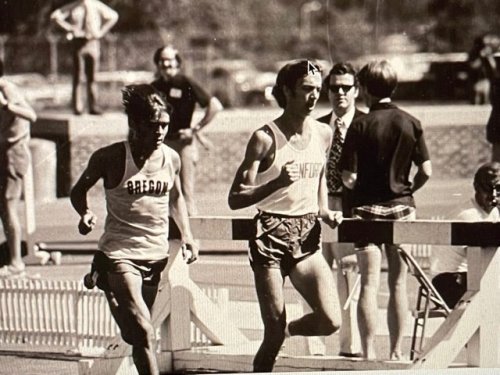
Don Kardong the fourth-place finisher in the Olympic Marathon ran in the Ultimate Runner one year. He recalls passing a dead raccoon in the last couple of miles of the marathon, "I thought the roadkill looked better than I felt. "He placed fifth overall…".
Kardong is in the lead in the picture above, racing against the legendary Steve Prefontaine from the USA. Marshall Clark, who coached Kardong at Stanford, later became my coach at the University of Montana after his time at Stanford.
Photo Credit: Original Gangsters Of Running (Don Kardong) – JDW
www.jackdogwelsh.com
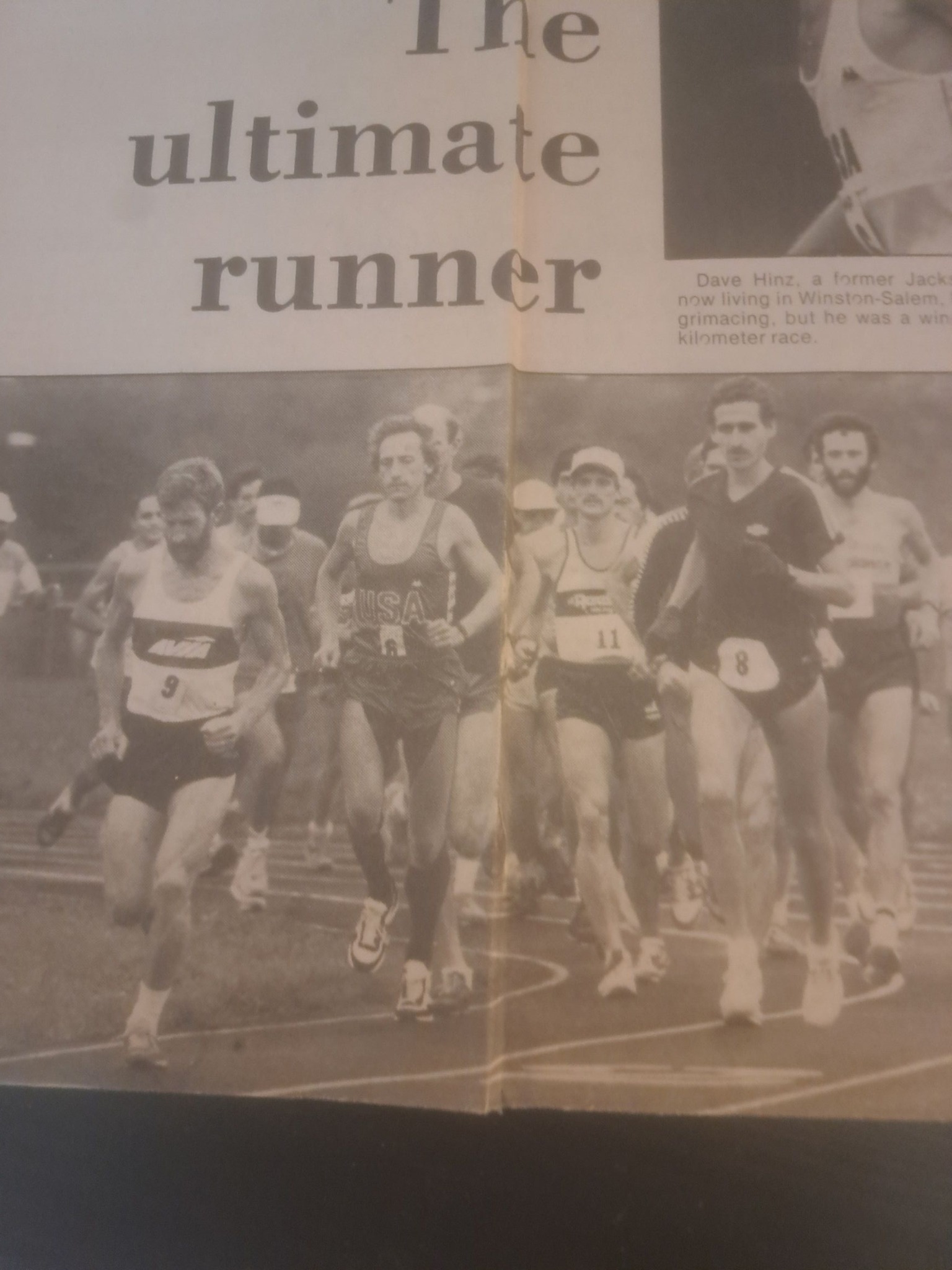
This picture marked the start of the marathon portion of the original Ultimate Runner. I am number 11 with the white cap next to 2:12 marathon runner Dave Hinz and Ultra Marathon Hall of Fame Runners Charlie Trayer, "called the father of America Ultrarunning", and next to 1500-meter Olympian John Craig.
The numbers on people's outfits roughly represented their rankings going into the event. Judging by my number 11, it was clear no one expected me to compete for the title that day.
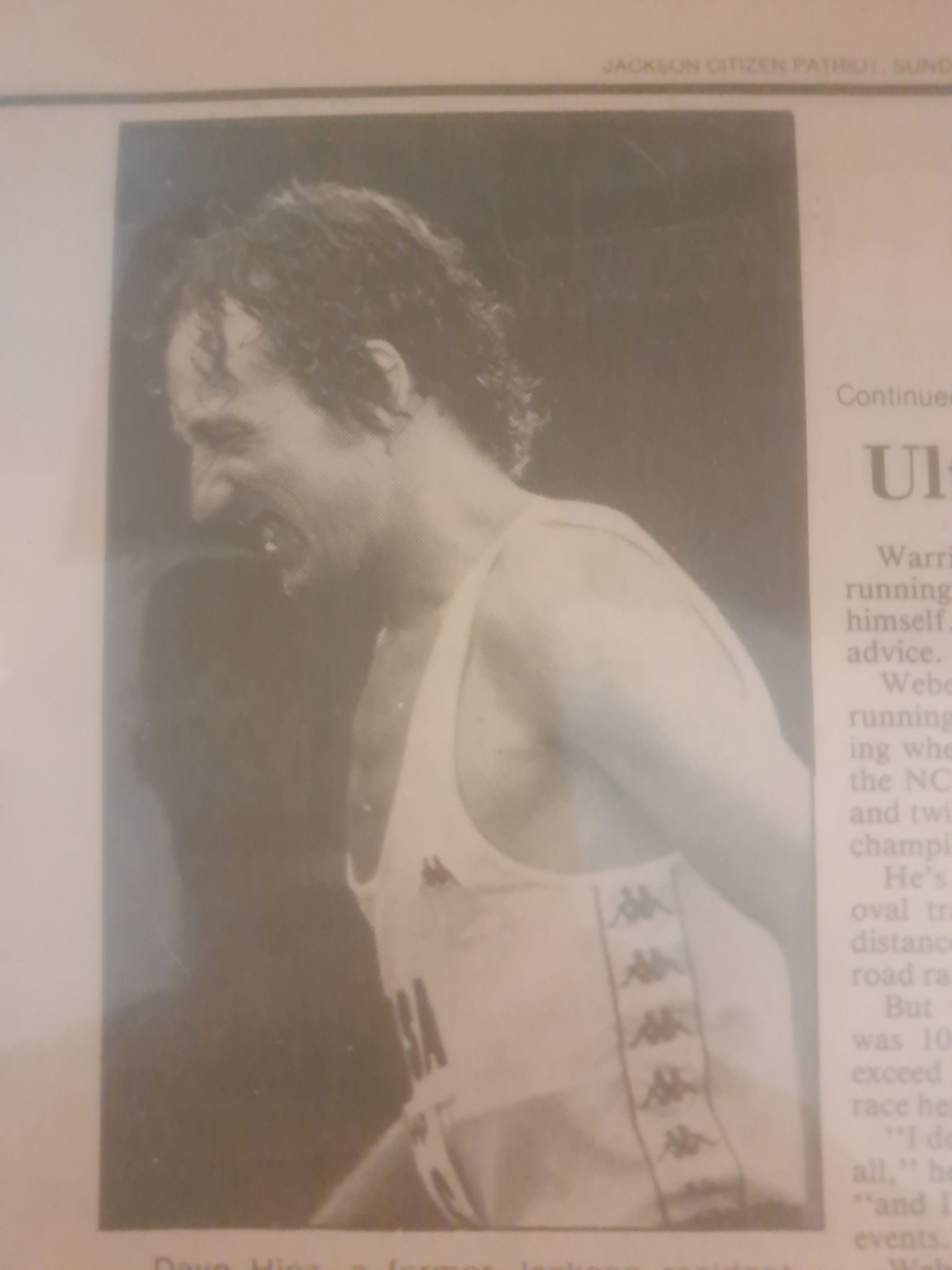
2:12 marathon runner Dave Hinz joined Olympic 1500-meter qualifier John Craig, saying they would never do the ultimate runner again because it was too hard on their bodies. Dave and John were great men, and it was fun to meet them.
This picture was taken after the first event of the day, the 10k.
The Original Ultimate Runner Competition was the most challenging physical event I have ever participated in, but I loved the concept of the event. I loved running the 100 meters to the marathon.
Image Credit: Jackson Citizen Patriot

Two months after the Original Ultimate Runner Competition, I ran with my Reebok Harriers team at the USA Cross-Country Championships. I was still not recovered from the Ultimate Runner Competition in this picture. I am number 40 in the photo next to a current Master's world champion and USATF Master's Hall of Fame member, Rick Becker, number 37.
Photo credit: Mrs. Adams
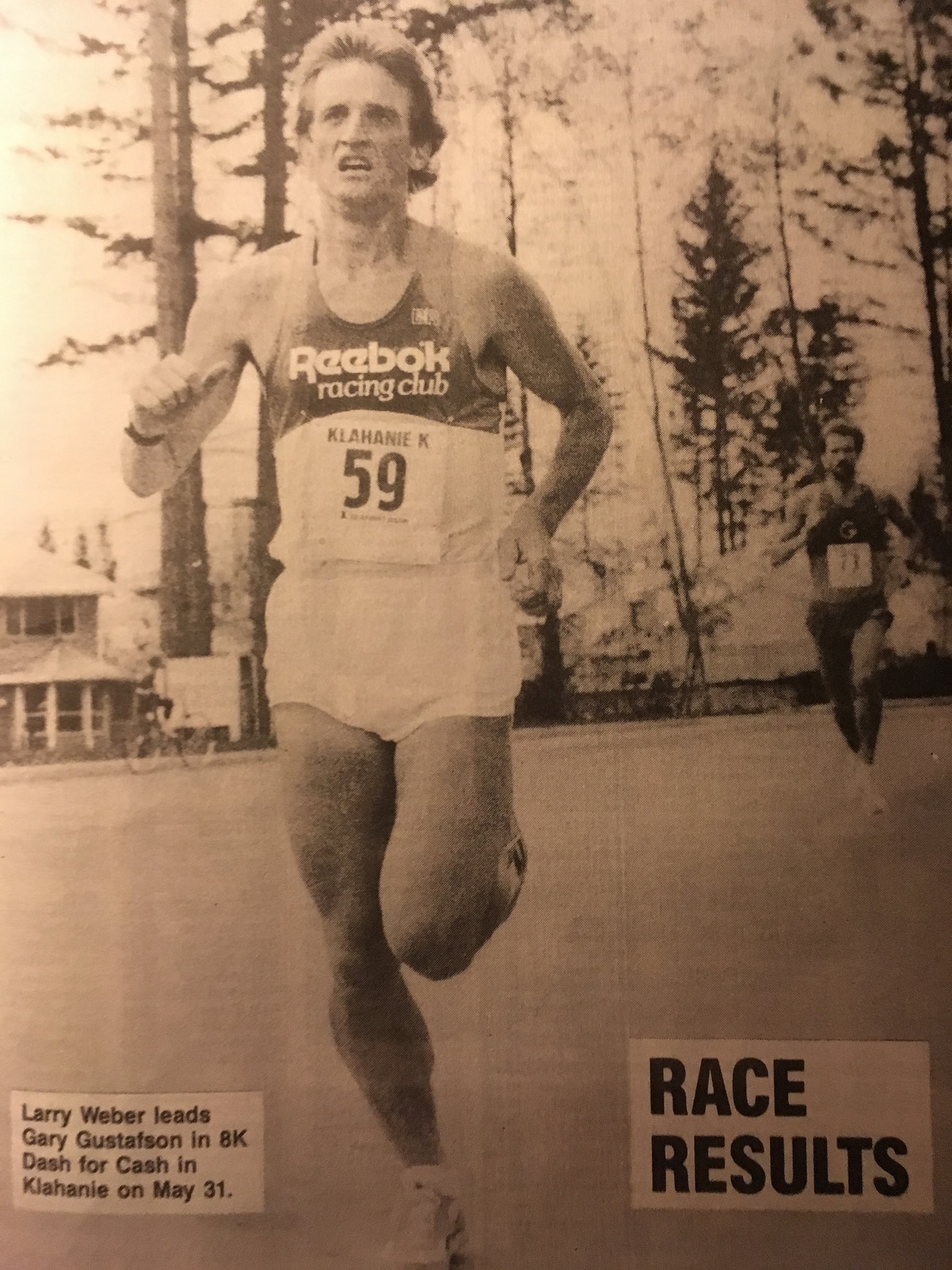
This was my last major race before retiring from competition. I won the race over long-time rival and friend Gary Gustafson. Gary was a 3:58 miler and USA Track and Field 1500-meter finalist who beat me at the USA National Track and Field Championships.

Eluid Kipchoge Photo
I will close with a quote from the greatest marathon runner in the world as of 2022. The next generation would do well to follow the advice of a two-time Olympic Marathon Winner and the first person to break 2 hours in the marathon, Eluid Kipchoge. Kipchoge's famous tagline is, "No Human Is Limited."
You can always do more than you initially believed.
Epilogue
Why was the Original Ultimate Runner one of the toughest one-day running events in history? Decades later, I’ve reflected on that question and the physiological toll of the race. Even if I had known the impacts, I probably still would have competed, but I would have trained even harder for that one-day test of human endurance.
1. The Demands of Running Every Energy System in One Day
Most races test one primary physiological system:
· Sprints (100m–400m): Anaerobic power, extreme oxygen debt.
· Middle distance (800m–3k): High VO₂ max demand, lactate tolerance.
· Marathon & long races: Aerobic endurance, glycogen management, muscular resilience.
The Original Ultimate Runner forced an athlete to compete at race intensity in all of these systems within a single day—a demand no other event matches.
2. Running All-Out Across the Spectrum
Ultimate runner racers didn’t jog these races—they raced each one at a competitive pace, which meant:
· Sprints: They ran all out, pushing into severe oxygen debt. After 400m of effort, blood lactate levels can spike to more than 12 mmol/L, approaching the near-maximal human tolerance.
· Mile: This was run roughly at VO₂ max, where oxygen uptake plateaus but demand stays high. Physiologically, this is the most demanding sustainable effort an athlete can maintain (heart rate ~95–100% of maximum).
· 10K & Marathon: Runners had to switch gears and run at marathon pace, around 80–85% VO₂ max, while glycogen-depleted from earlier events—something marathoners typically prepare months for, not hours after sprints.
No recovery strategy could fully restore glycogen or clear lactate between races. You were stacking cumulative fatigue across every system.
3. Physiological Science of Why This Was the Toughest
· Metabolic Stress: Athletes usually train for years to specialize in one domain (sprinter vs marathoner). Runners in this race had to perform as a sprinter, miler, and marathoner—all in less than 10 hours.
· Crossover Fatigue: Running at VO₂ max (mile/5K) damages muscle fibers and depletes glycogen, making the subsequent aerobic demand of the marathon exponentially harder.
· Neuromuscular Cost: Sprinting creates micro-tears and nervous system fatigue that impair stride efficiency. By the marathon, your legs were already near failure.
· Psychological Load: Each event required a different racing mindset—explosive aggression in sprints, tactical pacing in the mile, pure grit in the marathon. Switching mental gears is itself draining.
· All-Out Effort: Unlike “ultra” races (which are steady, submaximal), the Ultimate Runner demanded maximal output across intensities—the true definition of “ultimate.”
4. Why It Surpassed Some Other Grueling Events
· Ultras (50K–100 miles): Primarily aerobic, rarely requiring oxygen debt or VO₂ max.
· Decathlon: Tests multiple skills, but not maximal endurance.
· Ironman Triathlon: Brutally long, but at steady sub-VO₂ max pacing.
The Original Ultimate Runner uniquely demanded that an athlete:
· Sprint like a 400m specialist
· Endure like a marathoner
· Push VO₂ max like a miler
· Do it all in one continuous day, without specialization
From a physiological standpoint, no other event compressed the entire running spectrum into a single gauntlet.
Race-by-Race Breakdown of the Original Ultimate Runner Event Pace/Intensity Physiological System Engaged Scientific Effect on Body Impact on Later Races
100m Max sprint (95–100% speed) ATP-PC system (anaerobic alactic) Explosive effort fueled by stored phosphocreatine. Rapid depletion, high neuromuscular demand. Nervous system fatigue, legs already taxed before longer anaerobic races.
400m Maximal sprint endurance Anaerobic glycolytic + aerobic crossover Deepest oxygen debt; lactate can reach 12–15 mmol/L, HR ~100% max. Muscles flooded with lactate, legs trashed, aerobic system forced to work harder in the next race.
Mile (1600m) VO₂ max effort Aerobic power at ceiling At maximum heart rate and lung capacity, oxygen uptake plateaued, but lactate levels continued to rise. Aerobic and anaerobic systems both overtaxed; glycogen drain begins.
10K Hard race pace (~85–90% VO₂ max) Aerobic endurance. With glycogen already low, the body shifts to fat metabolism; prior sprints compromise stride efficiency. Early onset fatigue, a marathon feels like starting at “the wall.”
Marathon (26.2 miles) Race pace (~75–85% VO₂ max): Aerobic endurance, glycogen, and fat metabolism. Typically, it requires months of tapering and fueling; here, it is done in a state of glycogen depletion and muscle damage. Ultimate test: sustaining pace despite compounded fatigue from every energy system taxed earlier.
✅ Science-based conclusion:
The Original Ultimate Runner—— was probably one of the toughest one-day
running event in history because it forced the body to operate at oxygen
debt (anaerobic), VO₂
max (aerobic power), and marathon pace (aerobic endurance) all
in succession, under cumulative fatigue. Unlike any ultra, triathlon, or
decathlon, it tested every energy system at racing intensity in one day—a
true definition of “ultimate.”
I could not life my legs to get on the awards stand after the race. There was nothing left in the tank.